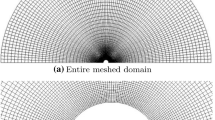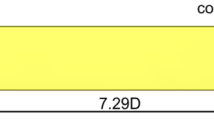Abstract
A computational fluid dynamics method has been applied to simulate the unsteady aerodynamics of the projectile launched from a ballistic range. A moving coordinate scheme for a multi-domain technique was employed to investigate the unsteady flow with moving boundary. The coordinate system fixed to each moving domain was applied to the multi-domains, and the effect of virtual mass was added in the governing equations for each domain. The unsteady, axisymmetric Euler equation systems were numerically solved using the third order Chakravarthy-Osher total variation diminishing scheme, with MUSCL approach. The projectile mass and configuration effects on the unsteady aerodynamics were investigated based on the computational results. The present computations were validated with results of some other CFD works available. The computed results reasonably capture the major flow features, such as shock waves, blast waves, shear layers, vertical flows, etc. which are generated in launching a projectile up to a supersonic speed. The present computational method properly predicts the velocity, acceleration and drag histories of the projectile.
Similar content being viewed by others
Abbreviations
- A:
-
Area, m2
- D:
-
Drag force, N
- E:
-
Total energy, J
- F:
-
Convection flux tensor
- M:
-
Momentum, kg.m/s2
- Ma :
-
Mach number
- n:
-
Outer unit normal vector at the cell surface
- p:
-
Pressure N/m2
- Q:
-
Conservative variable Vector
- S:
-
Source Vector
- T:
-
Temperature, K
- T:
-
Time, s
- U:
-
Velocity vector
- u:
-
Velocity in X-direction, m/s
- v:
-
Velocity in Y-direction, m/s
- x, y, and z:
-
coordinate axes
- γ:
-
Ratio of specific heats
- ρ:
-
Density, kg/m3
- ξ, η and ξ:
-
Transformed coordinates
- G, g:
-
Grid
- 1, 2 and 3:
-
Coordinate directions
References
Baker, W. B., 1974, “Explosion in Air,” University of Texas Press, Austin.
Chakravarthy, S. R. and Osher, S., 1985, “A New Class of High Accuracy TVD Schemes for Hyperbolic Conservation Laws,”AIAA paper 85–0363.
Erdos, J. I. and Del Guidice, R. D., 1975, “Calculation of Muzzle Blast Flow Fields,”AIAA J., Vol. 13, p. 1048.
Glass, I. I., 1974, “Shock Waves and Man,” The University of Toronto Press, Canada.
Jiang, Z., Takayama, K. and Skews, B. W., 1998, “Numerical study on Blast Flow Fields Induced by Supersonic projectiles Discharged from Shock Tubes,”Physics of Fluids, Vol. 10(1), p. 277.
Kim, H. D. and Setoguchi, T., 1999, “Study of the Discharge of Weak Shocks from an Open End of a Duct,”Journal of Sound and Vibration, Vol. 226, p. 1011.
Kim, H. D., Lee, D. H. and Setoguchi, T., 2002, “Study of the Impulse Wave Discharged from the Exit of a Right-angle Pipe Bend,”Journal of Sound and Vibration, Vol. 259, p. 1147.
Merlen, A. and Dyment, A., 1991, “Similarity and Asymptotic Analysis for Gun Firing Aerodynamics,”J. Fluid Mechanics, Vol. 225, p. 497.
Pope, A. and Goin, K. L., 1963, “High-Speed Wind Tunnel Testing”,John Wiley and Sons, New York.
Rizzi, A., 1982, “Damped Euler-Equation Method to Compute Transonic Flow around Wing-Body Combinations,”AIAA J., Vol. 20(10), p. 1321.
Schmidt, E. and Shear, D., 1975, “Optical Measurements of Muzzle Blasts,”AIAA, J., Vol. 13, p. 1086.
Steger, J. L., Dougherty, F. C. and Benek, J. A., 1983, “A Chimera Grid Scheme,”Advances in Grid Generation ASME FED-5, p. 59.
Sun, M., Siato, T., Takayama, K. and Tanno, H., 2005, “Unsteady Drag on a Sphere by Shock Loading,”Shock Waves, Vol. 14, p. 3.
Takakura, Y. and Higashino, F., 1997, “Numerical Study on the Sonic Boom Simulator Using a Ballistic Range,”21st International Symposium on Shock Waves (ISSW21), Great Keppel Island, Australia, July 20–25.
Takakura, Y., Higashino, F. and Ogawa, S., 1997, “Unsteady Flow Computations on a Flying Projectile within a Ballistic Range,”Computers & Fluids, Vol. 27(5-6), p. 645.
Takakura, Y., Ishiguro, T. and Ogawa, S., 1987, “On the Recent Difference Schemes for the Three-Dimensional Euler Equations,”AIAA paper 87–1151.
Takakura, Y., Ogawa, S. and Wada, Y., 1995, “Computations of A Transonic Wind-Tunnel Flows about a Fully Configured Model of Aircraft by Using Multi-Domain Technique,”AIAA Paper 93–3022.
Vinokur, M., 1989, “An Analysis of Finite-Difference Formulations of Conservation Laws,”J. Computational Physics, Vol. 81, p. 1.
Author information
Authors and Affiliations
Corresponding author
Rights and permissions
About this article
Cite this article
Gopalapillai, R., Kim, HD., Setoguchi, T. et al. On the near-field aerodynamics of a projectile launched from a ballistic range. J Mech Sci Technol 21, 1129–1138 (2007). https://doi.org/10.1007/BF03027663
Received:
Revised:
Accepted:
Issue Date:
DOI: https://doi.org/10.1007/BF03027663




